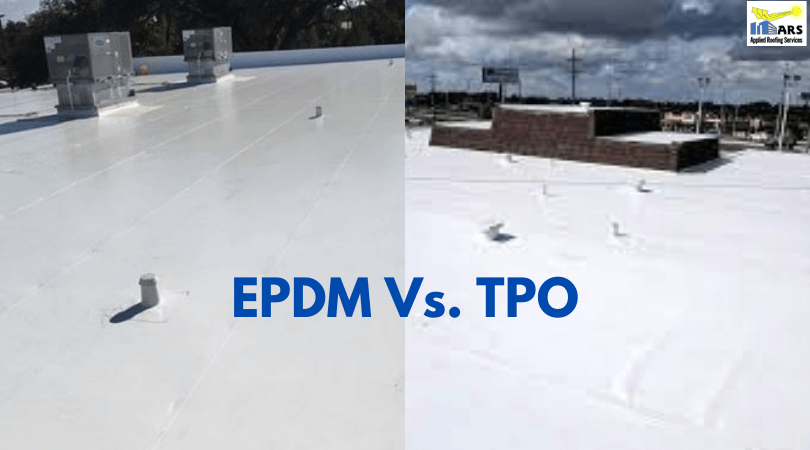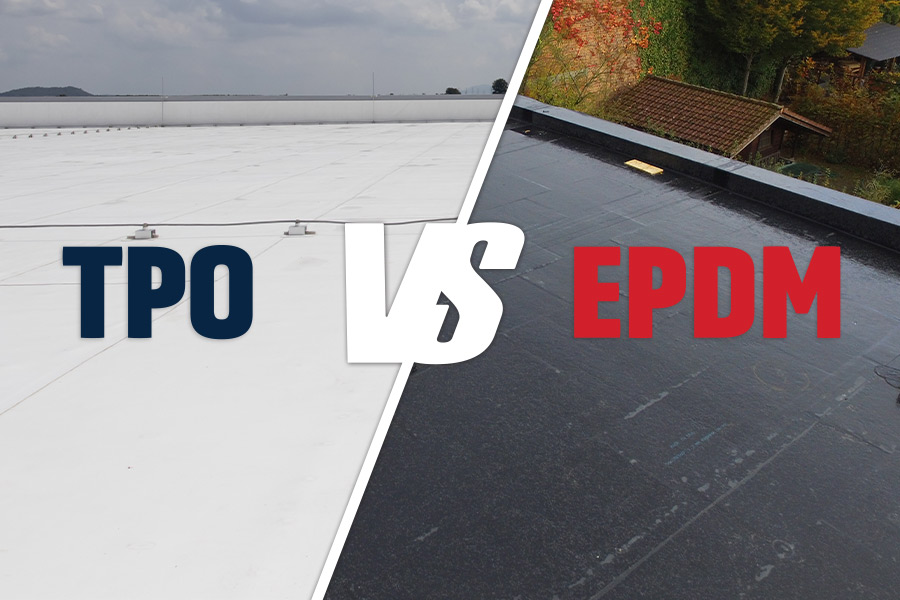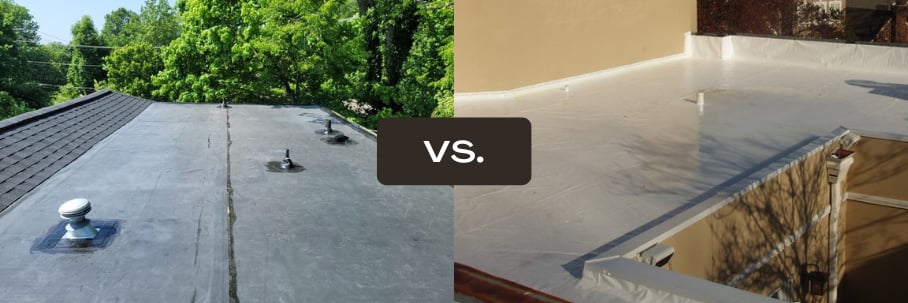If you’re in the market for a new roof, you may find yourself wondering, “Which is better: EPDM or TPO roofing?” Both options have their merits and it can be a tough decision to make. In this article, we will explore the advantages and disadvantages of each type of roofing, providing you with the information you need to make an informed choice. Whether you’re a homeowner or a business owner, this article will help you weigh the pros and cons of EPDM and TPO roofing, ensuring you select the best option for your needs.
Durability
EPDM Roofing Durability
EPDM (Ethylene Propylene Diene Monomer) roofing is known for its exceptional durability. It is highly resistant to sunlight, ozone, and extreme weather conditions such as hail, wind, and rain. EPDM roofs can withstand temperature fluctuations without cracking or shrinking, making them a great choice for areas with harsh climates. The rubber membrane used in EPDM roofing is also resistant to water, making it an excellent choice for areas with heavy rainfall or snowfall. With proper installation and maintenance, EPDM roofs can last for up to 30 years or more.
TPO Roofing Durability
TPO (Thermoplastic Olefin) roofing is also known for its durability. It is highly resistant to UV radiation, thermal expansion and contraction, as well as chemical and microbial attacks. TPO roofs have excellent puncture resistance and can withstand hail and other impact-related damages. The heat-welded seams in TPO roofing provide an added level of strength and durability. With proper installation and maintenance, TPO roofs can last for up to 20-30 years.
Comparison
When comparing EPDM and TPO roofing in terms of durability, both options offer excellent longevity. EPDM roofing has a slightly longer lifespan than TPO, with the potential to last up to 30 years or more. However, TPO roofing still offers a respectable lifespan of 20-30 years. Ultimately, the choice between EPDM and TPO should be based on other factors such as cost, environmental impact, and energy efficiency.
Installation
EPDM Roofing Installation
EPDM roofing installation is relatively straightforward and can be done by both professionals and skilled DIY enthusiasts. The EPDM membrane is available in large rolls, which are cut to fit the dimensions of the roof. The membrane is then adhered to the roof using adhesives or mechanically attached with screws and plates. Seams are typically overlapped and sealed using specialized tapes or adhesives. Proper installation techniques are crucial to ensure the longevity and effectiveness of the roof.
TPO Roofing Installation
TPO roofing installation is similar to EPDM roofing installation and can also be performed by professionals or experienced individuals. The TPO membrane is available in rolls, which are cut and fitted to the roof’s dimensions. The membrane is then heat-welded together to create a seamless and watertight bond. Additionally, the membrane can be mechanically fastened to the roof using screws and plates, similar to EPDM roofing. It is important to follow manufacturer guidelines and industry best practices during TPO roofing installation to ensure optimal performance.
Comparison
Both EPDM and TPO roofing systems are relatively easy to install, and the installation processes share many similarities. However, TPO roofing requires heat-welding to create a seamless bond, which can be more challenging and time-consuming compared to EPDM roofing. The ease of installation may depend on the individual’s skill level or the availability of professional installation services in your area.

Cost
EPDM Roofing Cost
EPDM roofing is known for its affordability compared to other roofing options. The cost of EPDM roofing can vary depending on factors such as the size of the roof, location, and complexity of the installation. On average, the cost of EPDM roofing materials ranges from $0.80 to $1.50 per square foot. When including labor and installation costs, the total price can range from $5 to $8 per square foot.
TPO Roofing Cost
TPO roofing is also considered a cost-effective option for commercial and residential roofing projects. The cost of TPO roofing materials is comparable to EPDM, ranging from $0.80 to $1.50 per square foot. However, TPO roofing installation may require more specialized equipment and expertise, which can increase labor costs. Including labor and installation expenses, the total cost of TPO roofing typically ranges from $6 to $10 per square foot.
Comparison
When it comes to cost, both EPDM and TPO roofing offer affordability compared to other roofing materials such as metal or asphalt shingles. The material costs for EPDM and TPO are similar, but the installation costs for TPO may be slightly higher due to the need for specialized equipment. However, the overall cost will depend on various factors such as the size of the roof, location, and complexity of the installation. It is advisable to obtain multiple quotes from reputable roofing contractors to determine the specific costs for your project.
Environmental Impact
EPDM Roofing Environmental Impact
EPDM roofing is considered an environmentally friendly roofing option. The manufacturing process for EPDM roofing does not release harmful chemicals or pollutants into the atmosphere. EPDM is also a recyclable material, allowing for the reuse of old membranes and reducing waste in landfills. Furthermore, EPDM roofs have a high solar reflectance, which helps reduce the urban heat island effect and lowers energy consumption for cooling.
TPO Roofing Environmental Impact
TPO roofing is also recognized for its environmentally friendly characteristics. TPO is a recyclable material, and some manufacturers offer post-consumer recycled content in their TPO membranes, further minimizing the environmental impact. Additionally, TPO roofs have a high solar reflectance, contributing to energy efficiency and reducing the demand for air conditioning.
Comparison
Both EPDM and TPO roofing options have positive environmental attributes. They are recyclable materials, which reduces waste and promotes sustainability. Additionally, their high solar reflectance helps to mitigate the urban heat island effect and reduces energy consumption. The decision between EPDM and TPO roofing regarding environmental impact may come down to individual preferences and specific project requirements.

Energy Efficiency
EPDM Roofing Energy Efficiency
EPDM roofing provides excellent energy efficiency benefits. The rubber membrane used in EPDM roofing has a high solar reflectance, which minimizes heat absorption from the sun and reduces cooling energy requirements. Additionally, EPDM roofs can be paired with insulation to further improve energy efficiency and reduce heating and cooling costs. The insulation properties of EPDM roofing contribute to maintaining a comfortable indoor temperature throughout the year.
TPO Roofing Energy Efficiency
TPO roofing is also highly regarded for its energy efficiency. The reflective properties of TPO roofs help to reduce heat absorption, keeping the building cooler and lowering the demand for air conditioning. TPO roofs can be combined with insulation to enhance energy efficiency even further, resulting in potential energy savings and reduced utility costs.
Comparison
Both EPDM and TPO roofs offer notable energy efficiency benefits. The high solar reflectance of both roofing systems helps to minimize heat absorption, reducing the need for cooling and potentially lowering energy consumption. The decision between EPDM and TPO roofing in terms of energy efficiency may depend on other factors such as cost, durability, and installation requirements.
Maintenance
EPDM Roofing Maintenance
EPDM roofing requires minimal maintenance. Regular inspections are recommended to ensure any potential issues, such as punctures or loose seams, are addressed promptly. Periodic cleaning with mild soap and water can help maintain the appearance of the roof and remove any debris or dirt buildup. EPDM roofs should be inspected after severe weather events to ensure there are no visible damages.
TPO Roofing Maintenance
Similar to EPDM roofing, TPO roofing also requires minimal maintenance. Regular inspections are essential to detect any signs of damage, such as punctures or loose seams. Cleaning the roof with mild soap and water can help remove any dirt or debris that may accumulate over time. After severe weather events, it is advisable to inspect the roof and address any potential issues promptly.
Comparison
Both EPDM and TPO roofing systems are relatively low maintenance options. Regular inspections and cleaning are recommended for both to ensure the longevity and effectiveness of the roofs. The frequency and extent of maintenance may depend on various factors such as the location of the building, weather conditions, and any external factors that may affect the roof’s integrity.

Weather Resistance
EPDM Roofing Weather Resistance
EPDM roofing is known for its exceptional weather resistance. The rubber membrane used in EPDM roofs is highly resistant to UV radiation, ozone, and extreme weather conditions such as hail, wind, and rain. EPDM roofs have excellent flexibility and can withstand temperature fluctuations without cracking or shrinking. The water-resistant properties of EPDM make it an excellent choice for areas with heavy rainfall or snowfall.
TPO Roofing Weather Resistance
TPO roofing is also recognized for its weather resistance. The TPO membrane has excellent resistance to UV radiation, thermal expansion and contraction, as well as chemical and microbial attacks. TPO roofs have high puncture resistance and can withstand hail and other impact-related damages. The heat-welded seams in TPO roofing provide additional strength and resistance against water penetration.
Comparison
Both EPDM and TPO roofing systems offer impressive weather resistance capabilities. They can withstand a range of weather conditions, including extreme temperatures, UV radiation, hail, wind, and rain. The choice between EPDM and TPO roofing regarding weather resistance may depend on other factors such as cost, installation requirements, and specific regional weather patterns.
Appearance
EPDM Roofing Appearance
EPDM roofing is available in various colors, including black and white. The choice of color can impact the appearance of the roof. Black EPDM roofs blend well with the surrounding environment and can provide a sleek, modern look. White EPDM roofs, on the other hand, have higher solar reflectance and can help reduce cooling energy requirements. EPDM roofs have a smooth and flexible appearance due to the rubber membrane, creating a visually appealing finish.
TPO Roofing Appearance
TPO roofing is typically available in a light-colored or white membrane. The white color contributes to high solar reflectance, reducing heat absorption and cooling energy demands. The clean and uniform appearance of TPO roofs can enhance the aesthetic appeal of a building, particularly in commercial or contemporary architectural designs. The thermoplastic material provides a smooth and even surface, contributing to a sleek appearance.
Comparison
Both EPDM and TPO roofing systems offer aesthetic appeal in different ways. EPDM roofing provides color options, allowing for customization and adaptation to various architectural styles. TPO roofing, with its white membrane, offers a clean and consistent appearance. The choice between EPDM and TPO roofing regarding appearance may depend on personal preferences, architectural considerations, and the desired visual impact of the roof.

Life Expectancy
EPDM Roofing Life Expectancy
EPDM roofing has a long life expectancy and can last for up to 30 years or more with proper installation and maintenance. The durable rubber membrane used in EPDM roofs has excellent resistance to UV radiation, temperature fluctuations, and weathering. By following manufacturer guidelines and implementing regular inspections and maintenance, EPDM roofs can provide reliable protection for decades.
TPO Roofing Life Expectancy
TPO roofing also offers a respectable life expectancy, typically ranging from 20 to 30 years. The thermoplastic material used in TPO roofs is designed to withstand UV radiation, thermal expansion and contraction, and other environmental factors. With proper installation, periodic maintenance, and timely repairs, TPO roofs can provide long-lasting performance.
Comparison
When comparing the life expectancy of EPDM and TPO roofs, EPDM has a slightly longer lifespan, potentially lasting up to 30 years or more. However, TPO roofing still offers a reliable lifespan of 20 to 30 years, making it a durable choice for commercial and residential applications. It is important to note that the actual life expectancy may vary depending on factors such as installation quality, maintenance practices, and environmental conditions.
Warranty
EPDM Roofing Warranty
EPDM roofing typically comes with warranties from the manufacturers, which can range from 10 to 30 years, depending on the specific product and manufacturer. The warranty covers defects in materials and workmanship, ensuring that the EPDM roofing system meets the expected performance standards. It is essential to carefully review the warranty terms and conditions to understand the coverage and any maintenance requirements that may affect the validity of the warranty.
TPO Roofing Warranty
Similar to EPDM roofing, TPO roofing also comes with warranties from the manufacturers. The warranty duration for TPO roofs can range from 10 to 30 years, depending on the manufacturer and product. The warranty provides coverage against defects and ensures that the TPO roofing system meets the expected performance standards. It is important to review the warranty details and any maintenance requirements to ensure compliance and preserve warranty coverage.
Comparison
Both EPDM and TPO roofs generally come with warranties from the manufacturers, covering defects and ensuring performance standards. The warranty duration for both roofing options can range from 10 to 30 years, depending on the manufacturer. It is crucial to carefully review the specific warranty terms and conditions for each product to fully understand the coverage, maintenance requirements, and any potential limitations.
In conclusion, when comparing EPDM and TPO roofing, it is important to consider factors such as durability, installation, cost, environmental impact, energy efficiency, maintenance requirements, weather resistance, appearance, life expectancy, and warranty. Both EPDM and TPO roofing systems offer excellent durability, relatively easy installation, cost-effectiveness, environmental friendliness, energy efficiency, low maintenance, weather resistance, aesthetic appeal, long life expectancy, and warranty coverage. The final choice between EPDM and TPO roofing will depend on individual preferences, project requirements, and specific factors such as budget, climate, and architectural considerations. It is advisable to consult with roofing professionals and carefully evaluate the pros and cons of each roofing option to make an informed decision.
